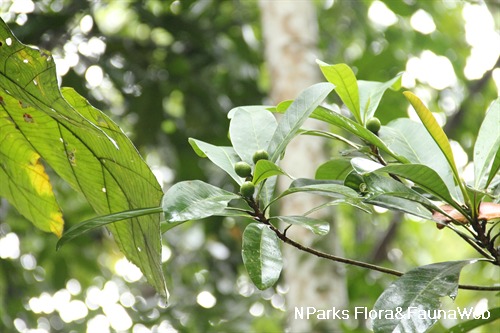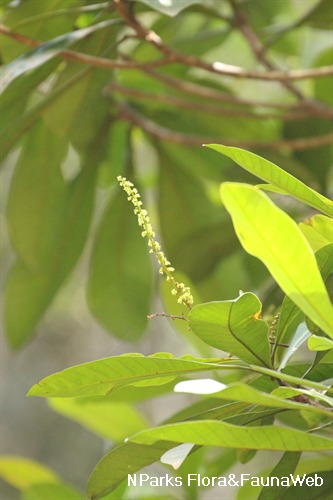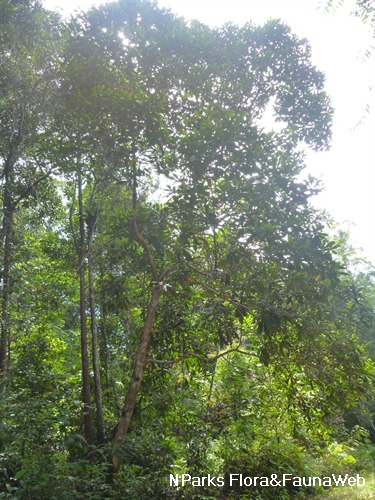_lowres.jpg)
Back
Campnosperma squamatum Ridl.
| Family Name: | Anacardiaceae |
| Synonyms: | Campnosperma minor Corner |
| Common Name: | Terentang Jantan |
Name
Classifications and Characteristics
| Plant Division | Angiosperms (Flowering Seed Plants) (Dicotyledon) |
|---|---|
| Plant Growth Form | Tree (Medium (16m-30m)) |
| Lifespan (in Singapore) | Perennial |
| Mode of Nutrition | Autotrophic |
| Plant Shape | Irregular |
| Maximum Height | 30 m |
Biogeography
| Native Distribution | Peninsular Malaysia, Singapore, and Borneo |
|---|---|
| Native Habitat | Terrestrial (Primary Rainforest, Freshwater Swamp Forest) |
| Preferred Climate Zone | Tropical |
| Local Conservation Status | Native to Singapore (Vulnerable (VU)) |
Description and Ethnobotany
| Growth Form | It is a tree up to 30 m tall. |
|---|---|
| Foliage | Its spirally arranged, very shortly-stalked leaves have thinly leathery leaf blades that are narrowly drop-shaped to spatula-shaped, or oval, and 6–61 by 2–14 cm. The base of the new leaves slightly widen towards the end of the short leaf stalk to form ear-like lobes (auricles) that encircle the stem. |
| Flowers | Its scantily-branched, flowering shoots are 4–29 cm long, and bear light-yellow or greenish-yellow flowers. |
| Fruit | Its roundish fruits are green-speckled white or dark green, and 12–17 by 10–17 mm. |
| Habitat | It grows in freshwater or peat swamp forests, and primary forests, from lowlands up to 1,200 m altitude. It occurs locally in Bukit Kallang, Old Upper Thomson Road, and the Central Catchment Nature Reserve. |
| Associated Fauna | Its flowers are insect-pollinated. |
| Cultivation | It can be propagated by seed. |
| Etymology | Greek Campnosperma, bent seed, referring to the shape of the seed; Latin squamatum, with scale-like leaves or bracts, referring to the scales on the surfaces of the leaf blades. |
| Ethnobotanical Uses | Others: It has horticultural potential based on its attractive large leaves and light-yellow or greenish-yellow flowers. |
Landscaping Features
| Landscaping | This tree may be suitable for parks and large gardens, and may be able to tolerate roadside conditions. Its tolerance for wet soil conditions will enable it to be grown in poorly drained sites. It can be propagated by seed. |
|---|---|
| Landscape Uses | General, Suitable for Roadsides, Parks & Gardens, Small Gardens, Riverine, Pond / Lake / River, Marsh / Bog, Shade Providing Tree / Palm |
| Thematic Landscaping | Naturalistic Garden |
Fauna, Pollination and Dispersal
| Pollination Method(s) | Biotic (Fauna) |
|---|---|
| Seed or Spore Dispersal | Biotic (Fauna) |
Plant Care and Propagation
| Light Preference | Full Sun, Semi-Shade |
|---|---|
| Water Preference | Moderate Water |
| Plant Growth Rate | Moderate |
| Rootzone Tolerance | Moist Soils, Waterlogged Soils (Drains Site, Does not Drain Site), Fertile Loamy Soils |
| Propagation Method | Seed |
Foliar
| Foliage Retention | Evergreen |
|---|---|
| Mature Foliage Colour(s) | Green |
| Mature Foliage Texture(s) | Leathery |
| Foliar Type | Simple / Unifoliate |
| Foliar Arrangement Along Stem | Alternate |
| Foliar Attachment to Stem | Petiolate |
| Foliar Shape(s) | Non-Palm Foliage (Obovate, Oval, Oblanceolate) |
| Foliar Venation | Pinnate / Net |
| Foliar Margin | Entire |
Floral (Angiosperm)
| Flower & Plant Sexuality | Bisexual Flowers |
| Flower Colour(s) | Yellow / Golden |
|---|---|
| Flower Grouping | Cluster / Inflorescence |
| Inflorescence Type | Panicle |
| Flower Colour(s) Remarks | Yellowish Green |
Fruit, Seed and Spore
| Mature Fruit Colour(s) | White, Green |
|---|---|
| Fruit Classification | Simple Fruit |
| Fruit Type | Fleshy Fruit , Non-Accessory Fruit |
Image Repository
Others
| Master ID | 30658 |
|---|---|
| Species ID | 4967 |
| Flora Disclaimer | The information in this website has been compiled from reliable sources, such as reference works on medicinal plants. It is not a substitute for medical advice or treatment and NParks does not purport to provide any medical advice. Readers should always consult his/her physician before using or consuming a plant for medicinal purposes. |


_lowres.jpg)
_lowres.jpg)
_lowres.jpg)


_lowres.jpg)
_lowres.jpg)